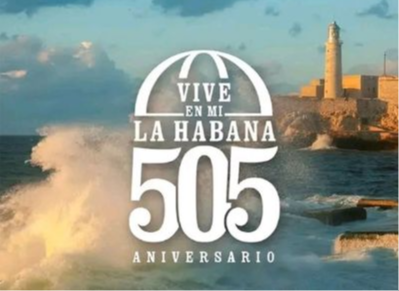
Havana turns 505
With its rich history and undeniable importance to the Cuban nation, Havana, the epicenter of tourism in the archipelago, celebrated its 505th birthday on November 16.
Despite the problems of a city burdened by economic problems, Havana celebrates its birthday with renewed brightness, even if it is in the respect of its traditions, culture and landscapes within its walls.
Declared one of the seven wonders of the world, Havana justifies this and many other awards not only for its beauty and mobility, but also for the traditions of its people.
The well-preserved urban landscape, thanks to the Office of the City Historian, Eusebio Leal (1942-2020) and the serious intentions of the Ministry of Tourism (Mintur) and other civic instances, allows a Babel-like panorama with people from all over the world.
Founded definitively in 1519 under the shade of a leafy tree, a ceiba, this city suddenly became very cosmopolitan, loaded with travelers from all over the world who want to get to know it better.
An enchanting atmosphere is breathed in its streets, where people come from all five continents, speaking their own language, but getting along with the capital in the only possible way: through cordiality.
Cuba, and Havana as an essence of essences, represent a very mixed people, where the main origins are Spanish and African, but also Chinese, Haitian, German, French, Hebrew and from many other parts.
The city of San Cristóbal de La Habana, as it is actually called, was founded on November 16, 1519 on the shores of Puerto Carenas, after a first settlement on the southern coast of the country in 1515.
This first city in the western part of the island is defined by historians as a place of greatness due to its monuments and a human scale related to its unique patrimonial values, where five centuries of history are settled.
The bay was the meeting point of the entire Spanish fleet on its way to the metropolis, carrying the riches of the entire Western Hemisphere, guarded by warships, under constant siege by pirates and people of all kinds.
Because of its particular attractiveness, the city was invaded by pirates in 1555 and by the English fleet in 1762, before which its walls and shelters, preserved pieces, stones and vestiges of great value to travelers.
All its richness was recognized by the United Nations Educational, Scientific and Cultural Organization (UNESCO) by declaring it a World Heritage Site in 1982.
Havana is the capital of the Republic of Cuba, it has a total area of 732 square kilometers and is divided into 15 municipalities, nine of which are entirely urban. Also, 4.5 square kilometers belong to the old part, the most interesting (with 2.2 kilometers in the recreational-historical axis).
This is the axis of tourism in Cuba, since more than 90 percent of all travelers who come to the country for recreation, business or medical treatment walk along its streets.
That is why today the panorama of a rejuvenated city sets the guidelines against ugliness, problems and in favor of a traditional city that everyone likes.
Its fortresses, in addition to archaeological preservation, represent appropriate scenarios for photography.
Some are dedicated to archaeology, such as La Punta, others to fairs and tourist visits, such as El Morro and La Cabaña, and others to gastronomy, such as La Chorrera, Havana's fortresses are a unique attraction for those who come to the Cuban capital.
They are scenarios with a lot of history, very well preserved and therefore one of the most relevant attractions, built to protect the then city of San Cristóbal de La Habana from the attacks of corsairs and pirates.
A good example, among many other bastions, is the Castle of Morro, which welcomes those who arrive in the city by sea.
The Castle of the Three Kings of Morro, stands on a high rock at the entrance of the bay. Its construction took 40 years, starting in 1589 and finishing in 1630.
Thus, El Morro, as it is simply known, has the shape of an irregular polygon, with thick walls, rising 40 meters above sea level, with bastions and defensive projections.
And as the most distinctive fact, it was a fundamental bastion to confront in 1762 the English squadron that seized it and from there propitiated the capture of Havana that lasted 11 months (until July 6, 1763).
Today, travelers recognize the 10-meter-high tower above the fortress, the maritime lighthouse, which served as a watch tower and has undergone several modifications: first fueled by firewood, in 1819 by oil, in 1928 by acetylene and finally, since 1945, by electricity.
Experts also mention the castle of the Real Fuerza, whose construction began in 1558 and was completed 20 years later, in 1578.
La Punta, together with El Morro, formed a crossfire against the attackers. It was built on a rocky outcrop, and it took 10 years to complete it in 1600, three decades before El Morro.
Meanwhile, the castle of San Carlos de La Cabaña was built in 1763 by order of Carlos III and became a 700-meter square with a 450-meter polygon of beautiful walls.
Dreamy fortresses, photographic spaces and scenarios preserved in time that now receive an appropriate enhancement for the 505th anniversary of Havana. (Taken from Prensa Latina)

